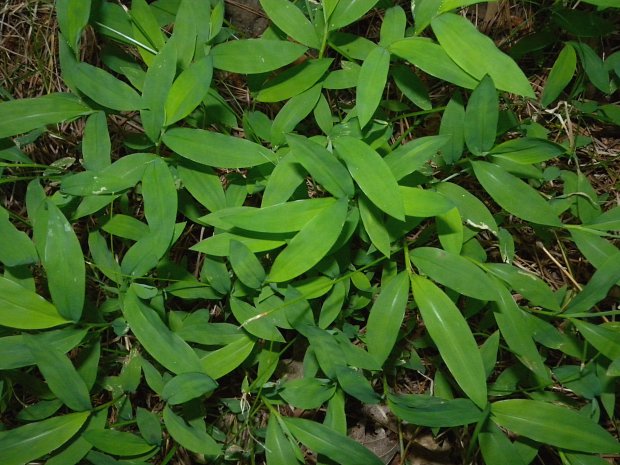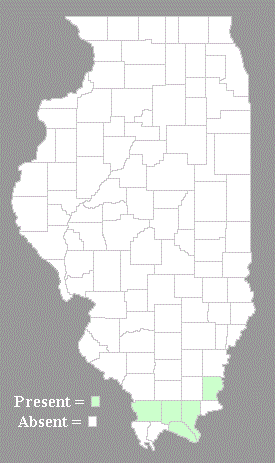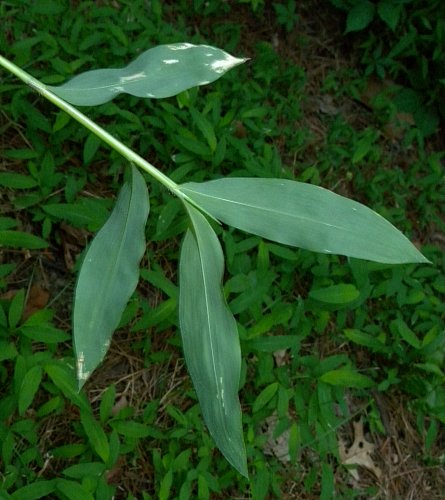
For each pair of spikelets, one spikelet is sessile, while the other spikelet has a short hairy pedicel (1.5-4.0 mm. in length). The spikelets are 4.5-6.0 mm. in length and single-flowered. Each spikelet consists of 2 glumes, 1 fertile lemma, and a perfect floret with 3 anthers. The glumes are 4.5-6.0 mm. in length, narrowly lanceolate, longitudinally veined, and ciliate along their margins. The lemma is much smaller and hidden by the glumes. The lemma is either awnless or it has an awn about 2-8 mm. in length; sometimes the awn is hidden by the glumes. In addition to the exerted racemes, several inserted racemes are produced that remain hidden within the upper sheaths. The exerted racemes are chasmogamous and cross-pollinated by the wind, while the inserted sheaths are cleistogamous and self-fertile. The blooming period occurs during early to mid-fall. Afterwards, ellipsoid grains develop that become 2.5-3.0 mm. in length at maturity. The grains are dispersed later in the fall with their lemmas (whether awned or awnless); they can be blown about by the wind or float on water. The root system is fibrous. This grass can spread vegetatively by forming new rootlets when the nodes of the decumbent culms remain in contact with moist soil. As a result, this grass often forms colonies of plants.
 Cultivation:
The preference is partial sun, moist conditions, and mildly acidic
to neutral soil containing some loam, including those with clay-loam,
sandy loam, and silty loam. However, Japanese Stiltgrass will tolerate
situations involving exposure to full sun, light shade, and even medium
shade, and it can colonize mesic to slightly dry areas. Even though
this grass prefers moist conditions and some shade, it has a C4
metabolism that enables it to grow throughout the summer,
regardless of the heat. In eastern North America, including Illinois,
this grass can be very invasive, forming large colonies that displace
other ground vegetation, therefore it should not be planted. The most
effective methods of eradication involve hand-pulling (for small
populations), the use of herbicides, and mowing during late summer
before the seedheads are produced. The grains can remain viable in the
ground for 3-5 years.
Cultivation:
The preference is partial sun, moist conditions, and mildly acidic
to neutral soil containing some loam, including those with clay-loam,
sandy loam, and silty loam. However, Japanese Stiltgrass will tolerate
situations involving exposure to full sun, light shade, and even medium
shade, and it can colonize mesic to slightly dry areas. Even though
this grass prefers moist conditions and some shade, it has a C4
metabolism that enables it to grow throughout the summer,
regardless of the heat. In eastern North America, including Illinois,
this grass can be very invasive, forming large colonies that displace
other ground vegetation, therefore it should not be planted. The most
effective methods of eradication involve hand-pulling (for small
populations), the use of herbicides, and mowing during late summer
before the seedheads are produced. The grains can remain viable in the
ground for 3-5 years.Range & Habitat: The non-native Japanese Stiltgrass occurs in southern Illinois at scattered locations, where it can be locally common. It was accidentally introduced into the United States from east Asia during the early 20th century, when it was first observed in Tennessee. This grass appears to be spreading in both disturbed and natural areas. Habitats include thinly wooded sandstone canyons, floodplain woodlands and riverbanks, woodland openings and borders, disturbed open woodlands, tree plantations, abandoned land that was mined, grassy areas in parks and around parking lots, and roadsides. While wildfire can kill this grass, it can reseed itself and become re-established.
Faunal Associations: The presence of Japanese Stiltgrass is associated with increased populations of leafhoppers, seedbugs (Lygaeidae), grasshoppers, and crickets. These insects apparently feed on this grass to some extent. In addition, a greater abundance of predatory insects, damsel bugs (Nabidae), apparently feed upon some of the preceding insects. Such mammalian herbivores as deer, horses, and goats usually avoid this grass when there is better vegetation to browse. This may be related to the silica content of its foliage. There is some evidence that populations of the White-Footed Mouse increase when Japanese Stiltgrass becomes more abundant as a result of the protective cover that its clonal colonies provide. To some extent, the grains of this grass spread to new locations as a result of the agency of animals and humans. The grains, particularly when they are accompanied by awns, can stick to the fur of mammals, the feathers of birds, and the clothing of humans; and they can be spread by muddy feet and shoes. Heavy construction and road maintenance equipment may spread the grains along roadsides through muddy tires, or plants with seedheads may become snagged on the undercarriages of such vehicles.
Photographic Location: Shaded grassy area of a park in southern Illinois.

Comments: Because of its paired spikelets, Japanese Stiltgrass (Microstegium vimineum) belongs to the same tribe of grasses, the Andropogoneae, as such prairie grasses as Big Bluestem (Andropogon gerardii) and Little Bluestem (Schizachyrium scoparium). Unlike these species, it is not a bunchgrass, instead forming a turf or mat like many lawn grasses. Especially during the vegetative state, it is possible to confuse Japanese Stiltgrass with the native White Grass (Leersia virginica); both grasses prefer similar habitats. While the inflorescences of these two grasses are fairly similar in appearance, there are important differences between them. White Grass does not produce its spikelets in pairs (there are no pediceled spikelets), and its spikelets are smaller (3.0-4.0 mm. in length). The spikelets of White Grass are unusual in that they lack glumes, possessing only a lemma and palea. In contrast, the spikelets of Japanese Stiltgrass have paired glumes that largely hide the lemmas from view. Another difference is that White Grass is a perennial that blooms a little earlier in the year (typically mid- to late summer), while Japanese Stiltgrass is an annual that blooms during the fall. Other scientific names for Japanese Stiltgrass include Eulalia viminea and Andropogon vimineus; these latter two names are regarded as obsolete. This non-native grass can be considered highly invasive of both disturbed and natural areas in Illinois and other states in eastern North America.